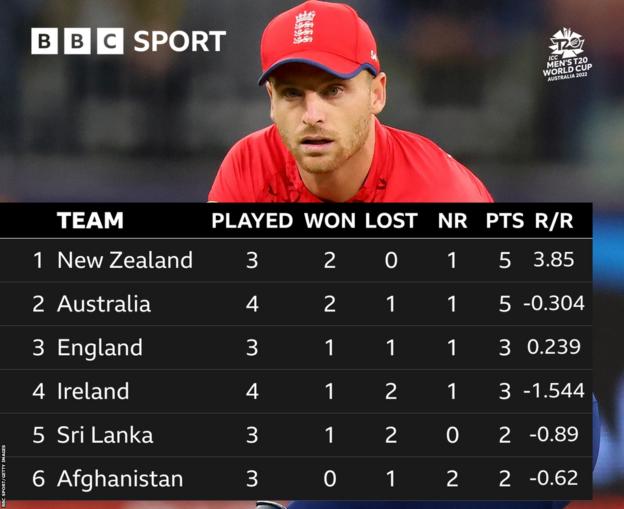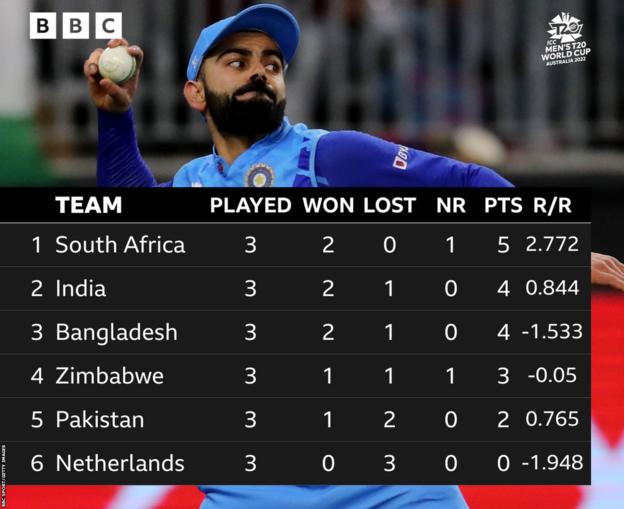ARTICLE AD BOX
 Australia, New Zealand, England and India are all hoping to reach the Men's T20 World Cup semi-finals
Australia, New Zealand, England and India are all hoping to reach the Men's T20 World Cup semi-finalsThe Super 12 stage of the Men's T20 World Cup is set for a thrilling climax with all to play for as we enter the final round of matches.
The top two from each group will qualify for the semi-finals, with 11 of the 12 sides still mathematically in with a chance of reaching the last four.
With a number of teams likely to end level on points, net run-rate could decide who progresses and who is getting the next flight home.
But what are the permutations? And how do you calculate net run-rate?
BBC Sport has been crunching the numbers to find out...
- T20 World Cup schedule
- Watch the best moments from the T20 World Cup
- Try our T20 World Cup mega quiz and vote for your winner
Group 1

Remaining fixtures (all times GMT): Tuesday, 1 Nov: Afghanistan v Sri Lanka (04:00), England v New Zealand (08:00). Friday, 4 Nov: Ireland v New Zealand (04:00), Australia v Afghanistan (08:00). Saturday, 5 Nov: Sri Lanka v England (08:00).
New Zealand are in a good position to progress to the last four. One victory in either of their two remaining games is likely to be enough to see them through, while two wins would guarantee it.
Australia moved into the top two with a 42-run win over Ireland on Monday. They are still likely to need a result against Afghanistan in their final game because of other games that remain. Even a victory in that game could see them eliminated because their net run-rate is currently inferior to New Zealand and England.
England were displaced by Australia, but have the chance to go back into the top two - and potentially even top - with a win over New Zealand on Tuesday. Two wins would practically guarantee England's progress, unless Australia beat Afghanistan by a large margin. Jos Buttler's side have the advantage of playing last in the group so they will know exactly what they need to qualify.
Ireland's hopes of reaching the semi-finals were dealt a major blow with the defeat to Australia on Monday. Victory over New Zealand on Friday could see them through, but it would need other results to go their way and a net run-rate swing.
Sri Lanka need to win both of their games and hope that Afghanistan beat Australia in their final game to go through.
Afghanistan need to win both of their games and hope that one of England or New Zealand lose at least one game.
Group 2

Remaining fixtures (all times GMT): Wednesday, 2 Nov: Zimbabwe v Netherlands (04:00), India v Bangladesh (08:00). Thursday, 3 Nov: Pakistan v South Africa (08:00). Sunday, 6 Nov: South Africa v Netherlands (00:00), Pakistan v Bangladesh (04:00), Zimbabwe v India (08:00).
South Africa's victory over India on Sunday put them in pole position to reach the final four. A win in one of their two remaining games would all-but guarantee their progress because only one of India and Bangladesh, plus potentially Zimbabwe, could match a seven-point tally.
India are also in a strong position and know that wins against Bangladesh and Zimbabwe would see them through. A defeat against the former in particular would put their progress in doubt though.
Bangladesh are similar and know that two wins sees them through. A win against India on Wednesday would put them into the top two, but they could miss out on net run-rate if they lose their final game.
Zimbabwe can still make the top two, but will need to beat the Netherlands and India to stand any chance because of the other fixtures that remain.
Pakistan can also still progress but need to win their remaining two games and hope numerous other results go in their favour. Even then they will be relying on net run-rate.
Netherlands are out after losing their first three games.
How is net run-rate calculated?
Run-rate is the average number of runs scored per over by a team in their entire innings - so, for example, a score of 160 off 20 overs equals eight runs per over.
Net run-rate is calculated by subtracting the opposition's run-rate from the other team's run-rate.
The winning side will therefore have a positive net run-rate, and the losers a negative net run-rate.
In a tournament, net run-rate is worked out by taking the average runs per over scored by that team in each game and subtracting the average runs per over scored against them in each game.
If a team is bowled out inside their allotted overs, their run-rate is calculated by dividing the runs by the maximum overs they could have batted - 20 overs in the case of this tournament.

 2 years ago
21
2 years ago
21








 English (US) ·
English (US) ·